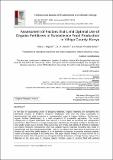| dc.contributor.author | Mary J Kipsat, D O Osewe, Mose Phoebe Bwari | |
| dc.date.accessioned | 2022-01-22T08:36:09Z | |
| dc.date.available | 2022-01-22T08:36:09Z | |
| dc.date.issued | 2021 | |
| dc.identifier.issn | 2231–4784 | |
| dc.identifier.uri | https://repository.maseno.ac.ke/handle/123456789/4502 | |
| dc.description.abstract | In the face of skyrocketing prices of inorganic fertilizers, organic materials are considered the alternative sources of fertilizers. Research institutions have over the years succeeded in demonstrating high yield responses to recommended usage of organic fertilizers. Furthermore, organic fertilizer (biofertilizers) is a vital component of sustainable agriculture. The sound management of organic fertilization must attempt to ensure both an enhanced and safeguarded environment. Most Farmers in Vihiga County have adopted use of organic fertilizers. Despite this, crop yields remain low in farmers’ fields due to low soil fertility and inability of farmers to optimally use organic fertilizers. Researchers often use optimal organic materials recording high yields in experimental and farm demonstration fields. Little or no research has been done to determine why farmers still record low yields despite a lot of extension outreaches to promote available organic matter technology packages in the study area. This paper reports findings of a study carried out to determine factors that limit optimal use of organic fertilizer by farmers in Vihiga County, Kenya. The objective of the study was to compare organic fertilizer usage in farmers’ field with optimal (recommended) rates to determine if the usage were significantly different. This was aimed at providing advice based on empirical evidence to farmers on whether there is need to improve usages of organic fertilizer and to determine if low intensity of organic fertilizer was a possible cause of recorded low yields in farmers’ fields. Purposive sampling was used to select farmers who were using organic fertilizer for soil fertility. A total of 120 farmers were selected to provide data needed for the study. Primary data was collected using questionnaires and data was analyzed using descriptive statistic (t-test). The results of the analysis indicated a significant difference in the usage between what farmers applied and what was recommended by research. Usages of organic fertilizer among the sampled farmers were much lower than the recommended levels explaining the low maize yields among farmers in the study area. The study rejected the hypothesis that the farmers’ usages of organic fertilizer was not statistically significant different from that recommended by research institutions. This is because average usage of organic fertilizer of 320.3 kg/ha was significantly below those recommended by researcher of 5ton/ha (at 99% usage. Farmers must follow appropriate promoted technology recommendations. The study recommended promotion of organic fertilizer. Farmers should be sensitized on the need to bridge the gap between the current and the recommended usage for them to realize the benefits of organic fertilizer. | en_US |
| dc.description.abstract | In the face of skyrocketing prices of inorganic fertilizers, organic materials are considered the alternative sources of fertilizers. Research institutions have over the years succeeded in demonstrating high yield responses to recommended usage of organic fertilizers. Furthermore, organic fertilizer (biofertilizers) is a vital component of sustainable agriculture. The sound management of organic fertilization must attempt to ensure both an enhanced and safeguarded environment. Most Farmers in Vihiga County have adopted use of organic fertilizers. Despite this, crop yields remain low in farmers’ fields due to low soil fertility and inability of farmers to optimally use organic fertilizers. Researchers often use optimal organic materials recording high yields in experimental and farm demonstration fields. Little or no research has been done to determine why farmers still record low yields despite a lot of extension outreaches to promote available organic matter technology packages in the study area. This paper reports findings of a study carried out to determine factors that limit optimal use of organic fertilizer by farmers in Vihiga County, Kenya. The objective of the study was to compare organic fertilizer usage in farmers’ field with optimal (recommended) rates to determine if the usage were significantly different. This was aimed at providing advice based on empirical evidence to farmers on whether there is need to improve usages of organic fertilizer and to determine if low intensity of organic fertilizer was a possible cause of recorded low yields in farmers’ fields. Purposive sampling was used to select farmers who were using organic fertilizer for soil fertility. A total of 120 farmers were selected to provide data needed for the study. Primary data was collected using questionnaires and data was analyzed using descriptive statistic (t-test). The results of the analysis indicated a significant difference in the usage between what farmers applied and what was recommended by research. Usages of organic fertilizer among the sampled farmers were much lower than the recommended levels explaining the low maize yields among farmers in the study area. The study rejected the hypothesis that the farmers’ usages of organic fertilizer was not statistically significant different from that recommended by research institutions. This is because average usage of organic fertilizer of 320.3 kg/ha was significantly below those recommended by researcher of 5ton/ha (at 99% usage. Farmers must follow appropriate promoted technology recommendations. The study recommended promotion of organic fertilizer. Farmers should be sensitized on the need to bridge the gap between the current and the recommended usage for them to realize the benefits of organic fertilizer. | en_US |
| dc.publisher | IJECC | en_US |
| dc.subject | Usage; organic fertilizers; subsistence food production; Kenya. | en_US |
| dc.subject | Usage; organic fertilizers; subsistence food production; Kenya. | en_US |
| dc.title | Assessment of Factors that Limit Optimal Use of Organic Fertilizers in Subsistence Food Production in Vihiga County, Kenya | en_US |
| dc.type | Article | en_US |

